Dual Core Snapdragon GPU Performance Explored - 1.5 GHz MSM8660 and Adreno 220 Benchmarks
by Brian Klug on March 30, 2011 4:29 PM EST- Posted in
- Smartphones
- Snapdragon
- Qualcomm
- Adreno
- MSM8660
- MDP
- Mobile
Quake 3... er... kwaak3
Quake has been a regular fixture in our mobile GPU benchmarking suite, and likewise we ran it on the MSM8660. It's starting to show its age however, as we've quickly gone from virtually unplayable framerates a little over a year ago to hitting the 60 FPS framerate cap on virtually every newish SoC.
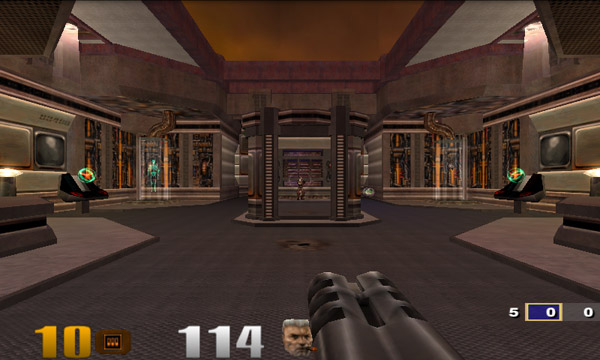
That said, it's still worth using to demonstrate performance gains, even if it isn't entirely representative of what game engines will look like going forward.
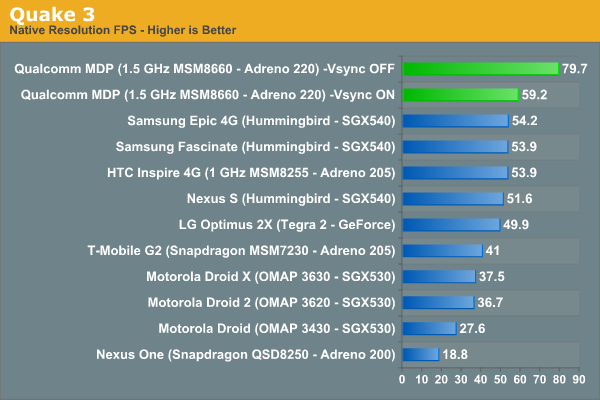
Here we can see just how obvious that framerate cap is by looking at the clustering of results right around 55-60 FPS. The cap on Qualcomm's MDP is a precise 60 Hz, but the cap on Hummingbird and others is around 56.
There's a significant jump from Adreno 200 to 205 of 2.9x, though it's likely we're capped on the Inspire 4G. I'd have numbers from the myTouch 4G as well, but it's impossible to get console to come up since the search button has been repurposed as the "Genius" button. Now I remember why I got stuck on that phone.
3DMark Mobile 2010
3DMark Mobile by Rightware is a new one for us. We've used Rightware's newer mobile GPU benchmark, Basemark, for some time now, but encountered instability on the MDP and MSM8660 and couldn't get test runs to complete and produce useable results. In addition there was some missing geometry and textures that we felt invalidated some runs.
Qualcomm provided us an APK of 3DMark Mobile 2010 which I ran on the MDP and all the other Qualcomm SoC-packing devices I had on hand. I'm not sure whether this APK was Adreno specific like I've heard 3DMM can be, but for whatever reason it didn't want to run on any other devices on hand from any other vendors. It is useful for showing generational performance differences between Adreno 200, 205, and 220, however.
The first test is Taiji and seems to be the more graphically demanding of the two, featuring some water pixel shading, normal mapping, and a complicated scene.
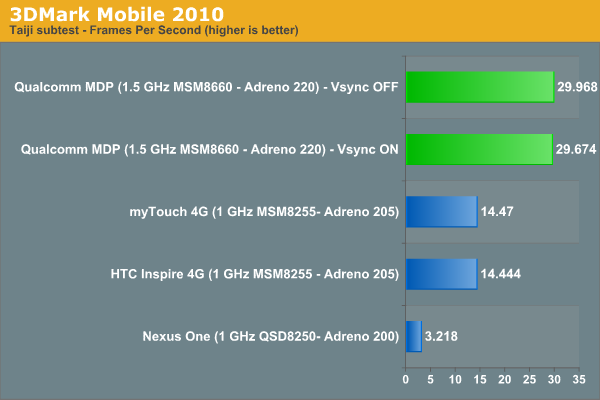
In Taiji we can see truly generational performance differences between the three Adreno GPUs. Adreno 205 is 4.5x faster than Adreno 200, and then Adreno 220 is 2.0x faster than Adreno 205. Keep in mind we're also dealing with different clock speeds and memory architectures between those last two, however.
The second test is Hoverjet, and isn't quite as demanding. Interestingly enough, Adreno 205 doesn't do quite as well here. There's now a 4.5x performance gain from Adreno 205 to Adreno 220.
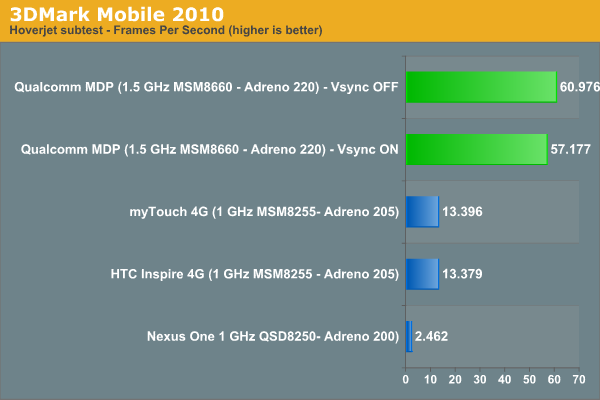
3DMark Mobile 2010 feels a bit old to us, and Rightware has indicated that Basemark will be their flagship mobile GPU benchmarking suite going forward. Once those stability issues are addressed, we'll finish running the MDP – and thus MSM8660 – and update things.
Quadrant 3D and 2D
Last and definitely least (at least in my mind) on the list is Quadrant, which has unfortunately become something of a de-facto one stop shop for benchmarking Android devices, famously spitting out one easy to digest score. Grab the pro version, and you get subtest scores. Its developers aren't very open about what all is being tested in the suite, the overall score is heavily skewed by I/O performance. Moreover the subtests themselves don't seem heavy enough for this current, much less upcoming, generation of SoCs. Benchmarking tools are rapidly evolving in the mobile space, and I expect to see far better tools quickly displace ones like Quadrant.
That said, we went ahead and ran the whole suite on the MDP just with Vsync off. I've seen some issues with Quadrant's 3D tests on Android 2.3 before, and the MDP was no exception. Again, we're going to do more CPU plus overall performance testing along with an architecture deep dive in an upcoming piece, but for now you can get a bit of that in the overall score.
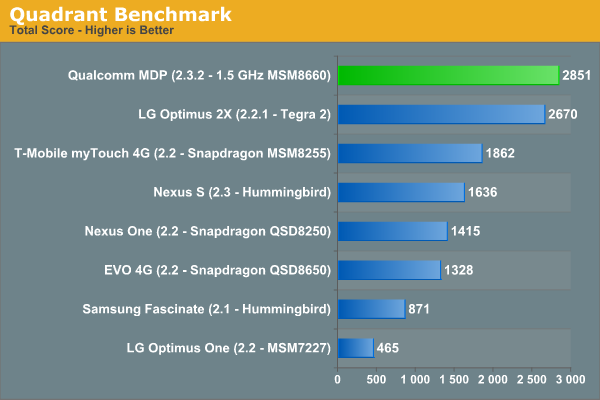
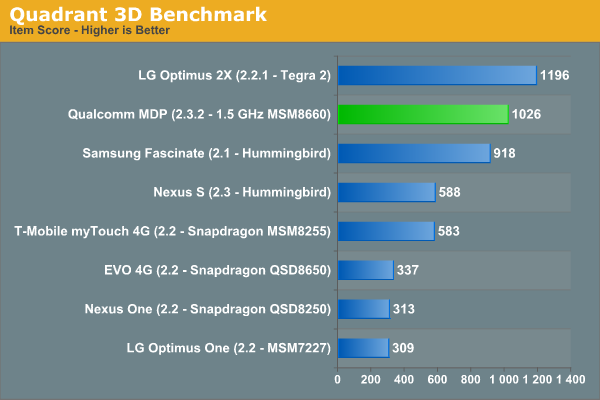
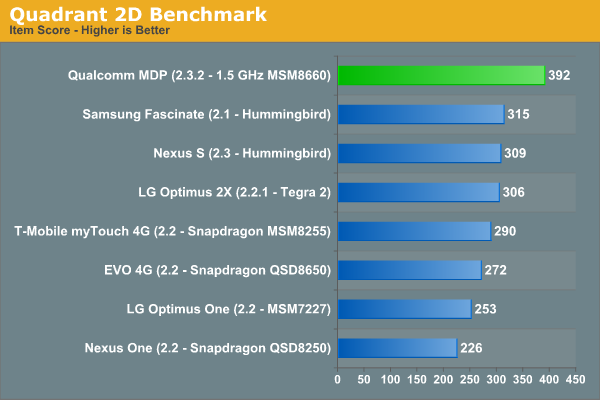
What all Quadrant is putting emphasis on with its 2D and 3D subtests is something of a mystery to me. There isn't a whole lot of documentation, but again it's become something of a standard. The 1.5 GHz MSM8660 leads in overall score and the 2D subtest, but trails Tegra 2 in the 3D subtest. If you notice the difference between Hummingbird (SGX540) from 2.1 to 2.3, you can see how Quadrant's strange 3D behavior on Android 2.3 seems to continually negatively impact performance. I saw the same odd missing texture and erratic performance back when I tested the Nexus S as I did on the MDP. Things like this and lack of updates are precisely why we need even better testing tools to effectively gauge performance.
As it is now, Adreno 220 shows anywhere from 2-5x performance gains over Adreno 205. Right now the reasons for those improvements aren't entirely clear, but we're going to do a GPU architecture deep dive relatively shortly and sort everything out. Likewise, we'll evaluate the 1.2 GHz MSM8660 and compare. Devices with the MSM8x60 aren't that far off - we're looking forward to getting our hands on the HTC Pyramid and EVO 3D which both will likely have 1.2 GHz MSM8x60 inside.
Final Words
When we first started looking at Qualcomm's Snapdragon SoCs we were impressed by their CPU performance but largely put off by the performance of the Adreno 200 GPU. The 45nm Snapdragon with the Adreno 205 GPU changed things as it roughly doubled GPU performance. The Adreno 220 brings about another doubling in GPU performance.
We'll eventually see more conservative GPU performance gains in line with Moore's Law, however for the foreseeable future these sorts of yearly generational improvements are to be expected.


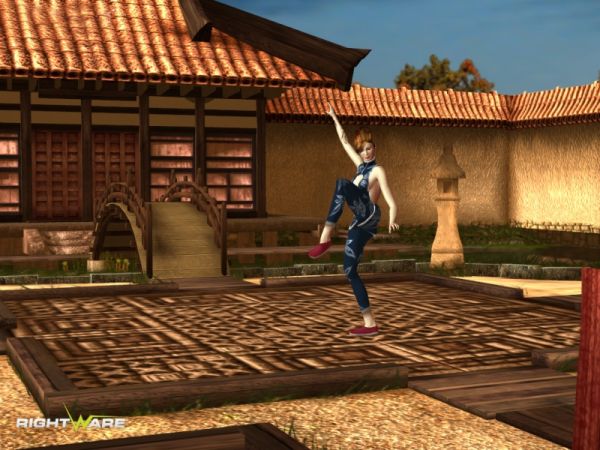









70 Comments
View All Comments
Griswold - Saturday, April 2, 2011 - link
Maybeso, but it will definitely run at a lower clockspeed.Blacula - Thursday, March 31, 2011 - link
The Samsung Galaxy Tab is in there too.djgandy - Thursday, March 31, 2011 - link
Looks like GLBenchmark is vsynced for the rest of the phones too.How exactly did you turn vsync off?
metafor - Thursday, March 31, 2011 - link
As mentioned in the article, it's a feature the development phone he used allowed but most phones don't.Chloiber - Thursday, March 31, 2011 - link
...when I look at 3DMark Mobile...my poor HTC Desire...Impressive performance! Looking forward to the HTC Pyramid ;)
duploxxx - Thursday, March 31, 2011 - link
uggh its very uglyalxxx - Thursday, March 31, 2011 - link
TI omap4460 is sampling according to TIhttp://focus.ti.com/general/docs/wtbu/wtbuproductc...
even though they haven't released the docs for omap4430
but can get them via pandaboard.org
see TRM http://pandaboard.org/content/resources/omap-devic...
omap5430 and 5432 look interesting
http://focus.ti.com/general/docs/wtbu/wtbuproductc...
Hey Brian or Anand how about getting a pandaboard and doing some benching.
You can load pandroid http://pandaboard.org/node/225/#android
http://omappedia.org/wiki/OMAP_Pandroid_Main
http://code.google.com/p/pandroid/
I'd volunteer mine but a bit to far away plus not familar with android, mostly run angstrom.
Other interesting one(for dsp people) is TI finally have their floating point dsps above 1Ghz
with the release of the new integra/sitra chips http://focus.ti.com/dsp/docs/dspcontent.tsp?conten...
FITCamaro - Thursday, March 31, 2011 - link
This is what I'm waiting for before I get a new phone. My Droid will be enough until then. I don't have 4G service in my area yet anyway.PWRuser - Thursday, March 31, 2011 - link
Hopefully the MDP has little RAM so that actual phones may perform better.It's early but in terms of performance, it appears that this SoC lines up somewhere between Tegra 2 and the (projected) Tegra 3 performance.
Also it will be interesting to see a refresh of this unit when the fab switches to 28nm.
SheldonCooper - Friday, April 1, 2011 - link
The Taiji test is pixel heavy since it is a closed environment whereas the Hoover test is texture heavy (lots of terrain). They are useful to compare unified shader vs dedicated pixel- and texture shader architecture.